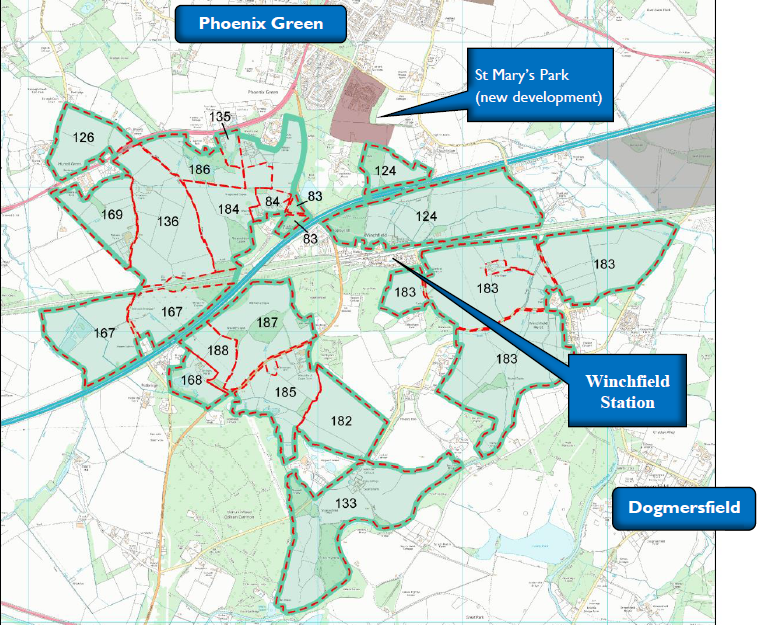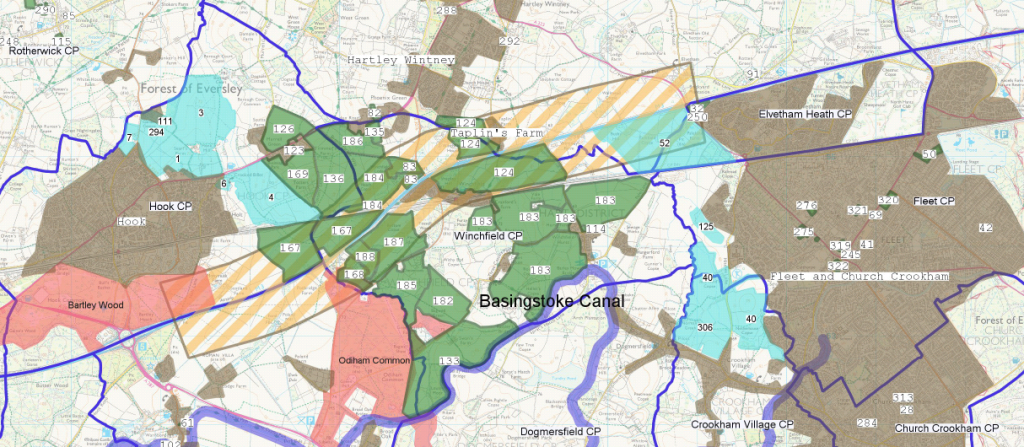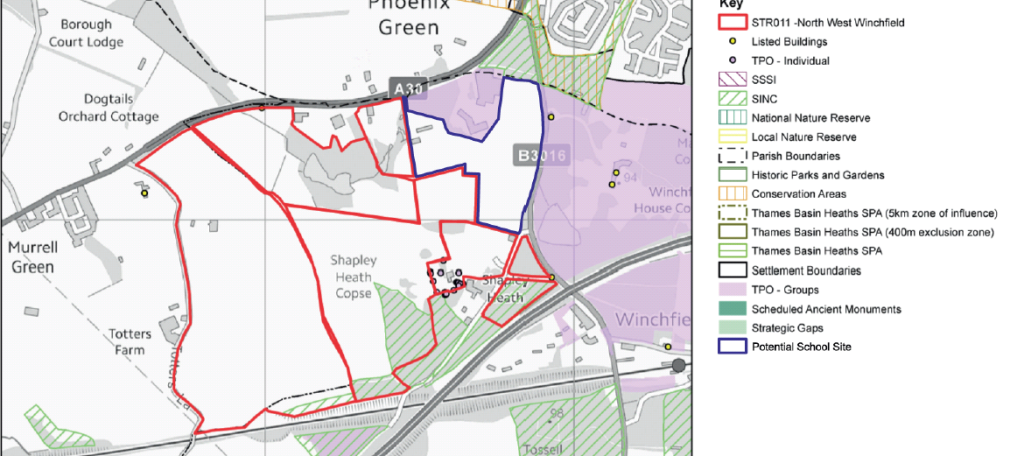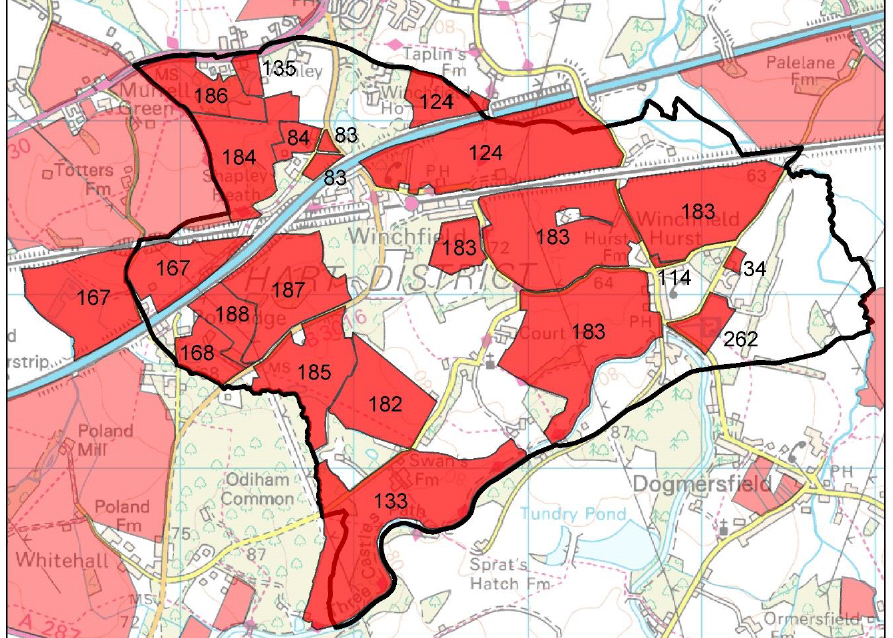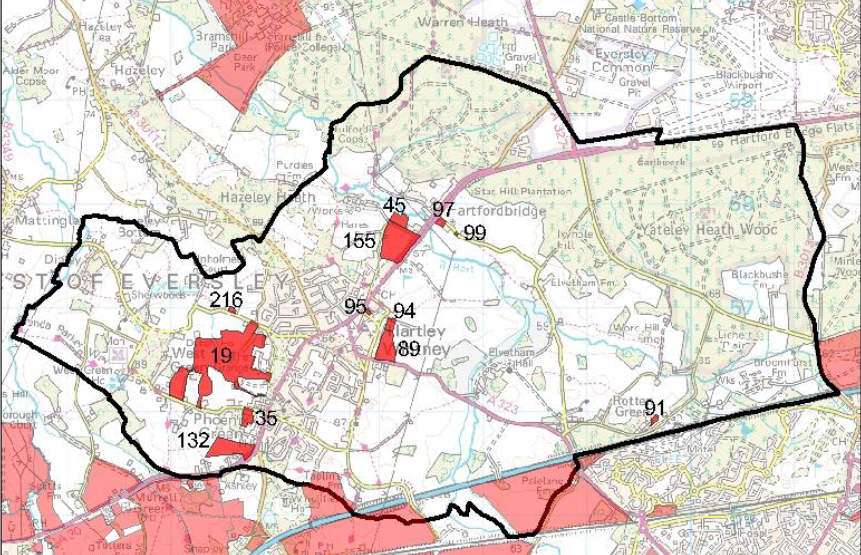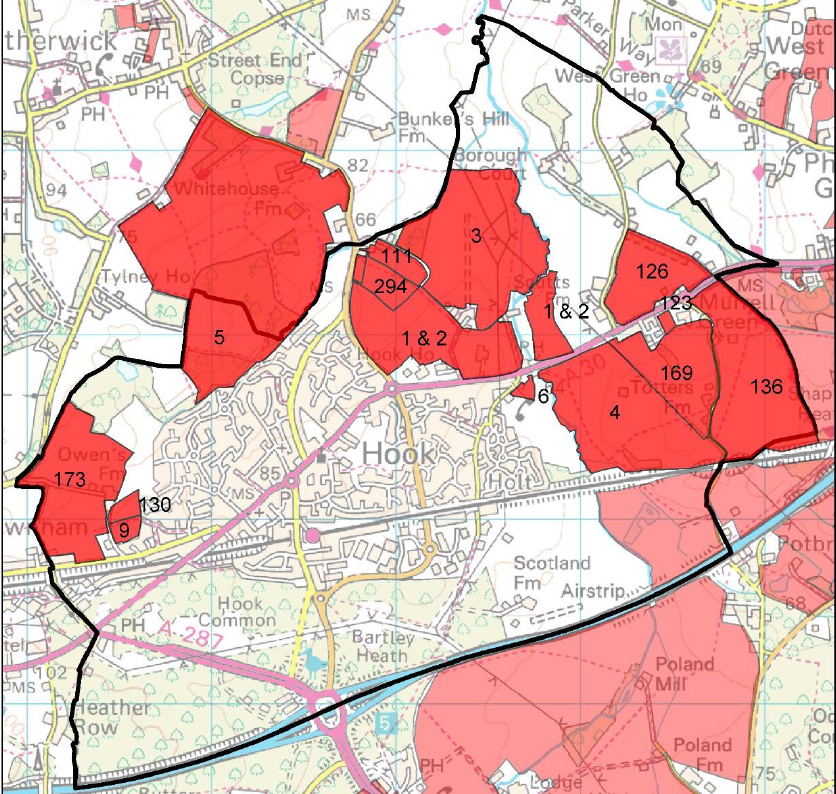Hart District Council have made much of the supposed infrastructure benefits of a new town in Hartley Wintney, Winchfield and Hook parishes to create a new Hartley Winchook conurbation. But they have so far failed to spell out the infrastructure costs and not disclosed where the money would come from. It is our belief that these alleged infrastructure benefits are a mirage and would not solve the acknowledged infrastructure issues in Fleet and Church Crookham. Any infrastructure money we get would be better spent regenerating our town centres and this can only be achieved with properly planned redevelopment of the numerous brownfield sites in our town centres.
Our estimate of infrastructure costs is over £300m, with the potential developer contributions of around £50m for a 5,000 house new town. On its own, this delivers a funding gap of at least £250m, on top of the existing £78m infrastructure funding deficit. The detail of our workings is shown below. It is clear that despite two years of work since the last Local Plan failed, the proposals for a new town simply have not been thought through, so it would be madness to vote for a new town in the consultation.
We have created a dedicated consultation page and two guides to responding to the consultation that are available on the downloads below. The comments are designed to be cut and pasted into the boxes provided. It will be very powerful if you could edit the comments into your own words. Please do find time to respond to the consultation and play your part in saving our countryside.
Full version:

2 Minute version:

Cost estimate:
| Infrastructure item | Number required | Cost per unit (£m) | Cost (£m) | |
|---|---|---|---|---|
| Roundabouts | ||||
| Roundabout (A30/B3016) | 1 | 4 | 4 | |
| Roundabout (A287/B3016) | 1 | 4 | 4 | |
| Roundabout (B3016/New Town) | 2 | 2.5 | 5 | |
| Roundabout (Pale Lane/A323) | 1 | 2.5 | 2.5 | |
| Roundabout (A287/Crondall Road) | 1 | 2.5 | 2.5 | |
| Roundabout (Pilcot Road/Hitches Lane) | 1 | 2.5 | 2.5 | |
| New Motorway Junction | 1 | 100 | 100 | |
| New roundabout on to A30 for SHL sites 126,136 & 169 | 1 | 4 | 4 | |
| Sub-Total Roundabouts | 124.5 | |||
| Bridges | ||||
| Bridge widening/strenghening River Hart at Queens Head | 1 | 1.5 | 1.5 | |
| Bridge widening/strenghening River Hart Pale Lane | 1 | 1.5 | 1.5 | |
| Railway bridges widening and strengthening | 3 | 5 | 15 | |
| Sub-Total Bridges | 18 | |||
| Roads | ||||
| New roads into new town (1.5km) | 1.5 | 2.1 | 3.15 | |
| Widening Bagwell Lane from new road to Station Road (1.5km) | 1.5 | 2.1 | 3.15 | |
| Widening Taplins Farm Lane/Church Lane to Barley Mow (2 km) | 2 | 2.1 | 4.2 | |
| Widening Station Road to the Hurst (2km) | 2 | 2.1 | 4.2 | |
| Widen Pale lane from Barley Mow to A323 (2km) | 2 | 2.1 | 4.2 | |
| Widen Chatter Alley/Pilcot Rd from Barley Mow to Hitches Lane (2km) | 2 | 2.1 | 4.2 | |
| Access road improvements to new station around Totters Lane | 2 | 2.1 | 4.2 | |
| Sub-Total Roads | 27.3 | |||
| Schools | ||||
| Secondary School | 1 | 60 | 60 | |
| Primary schools | 3 | 10 | 30 | |
| Sub-Total Schools | 90 | |||
| Sewage Works | ||||
| New Sewage works off Pale Lane to west of Edenbrook | 1 | 25 | 25 | |
| Sub-Total Sewage Works | 25 | |||
| Electricity Pylons | ||||
| Bury cables underground | 2.5 | 20 | 50 | |
| Sub-total Electricity pylons | 50 | |||
| Railway Station | ||||
| New Railway Station at Murrell Green | 1 | 25 | 25 | |
| Sub-Total Railway Station | 25 | |||
| Total | 359.8 |
The sources for these numbers are as follows, with some references to HDC’s Infrastructure Delivery Update:
- Roundabouts. Cost of A30 improvements at Blackbushe is around £4m. Roundabouts at either end of the B3016 will cross a dual carriageway and will likely require some element of approach road improvement, so reasonable to assume the cost of each change will be about the same. There will also no doubt need to be a new roundabout on to the A30 at Murrell Green. I have scaled down this number for the additional roundabouts needed as they are simpler.
- Bridge improvements estimated. Both bridges over the river Hart (at the Queens Head pub and on Pale Lane) will need to be completely replaced and widened to cope with two way traffic and probably some road adjustments too. The work on the railway bridges will be considerable to widen them to cater for two way traffic underneath, and potentially to strengthen them for double decker trains. Plus the Barratts new town plan for Winchfield shows a new footbridge over the motorway that hasn’t been individually costed. The bridge on Totters Lane over the railway will also need improvement, but we understand it is listed, so that will be difficult.
- Road costs estimated from this 2006 report from Imperial College London give a cost of £2.13m/km of new single carriageway road. Road lengths above taken from Google Maps. The infrastructure delivery update indicated that a new M3 junction may be required, although it is unclear where that would be located, nor is it clear where they would build the access roads. It is difficult to see how a brand new junction will give much change from £100m (despite Hart’s estimate of only £30m in the consultation papers), given a new junction at Birmingham airport will cost £250m.
- Schools. Hart Council have quoted £80-100m for new schools. I have chosen the mid-point of that estimate in the figures above. Note that the secondary school (according to both the Barratts vision document and the Hart strategic assessment of the Winchfield site) is within a couple of hundred metres of the M3 and next door to Mildmay Oaks hospital where a convicted sex offender escaped earlier this year and one of the primary schools is located between the M3 and the railway, hardly a suitable environment for children to grow up in.
- Sewage Works. The cost of water treatment works varies considerably. For example a new works at Newton-on-Trent to serve part of Lincoln cost £45m and an upgrade to the Mogden works cost £145m. So, I’ve gone for a conservative £25m, which may well be an under-estimate. Foul water drainage was identified as a significant barrier to future housing development.
- Electricity Pylons. No-one is going to want to live underneath high voltage electricity pylons, and two lots of high voltage pylons cross the planned area for the new town. Presumably they were put there originally because they weren’t near where people live. It costs £1.6m/km to lay new pylon runs and £20m/km to bury cables. The infrastructure delivery update indicated that burying the cables may be required “if these sites are to be developed optimally”, so I have used that figure in the calculations.
- Railway Station. It cost over £8m to upgrade the facilities and car-park at Fleet, and even more expensive works would be required at Winchfield: it also cost £4m to extend the platforms at Bedford station. But the infrastructure delivery update indicated that Winchfield station may be relocated and expanded, most likely to the west (north of the M3). The potential advantages of this approach would be that the existing station could continue to operate until the replacement station opened. We have therefore estimated a cost of £25m for a new station and believe that this may well be an understatement, because the land will also need to be purchased and big road improvements would be needed on say Totters Lane to allow access to the new station.
Contribution estimate
We might expect around £50m from developing 5,000 new houses that have not yet received planning permission in the local plan. This is based on only 3,000 houses being eligible for a CIL charge as 40% of what is built has to be “affordable” and does not attract a CIL charge. If each house is 95 sq m, and the charge per sq m is £175, then this results in CIL funding of ~£50m. If they use S106 instead of CIL, the yield can be expected to be broadly similar.
If anyone wishes to put forward an alternative or better estimate, with sources, we will gladly update our estimates accordingly.
